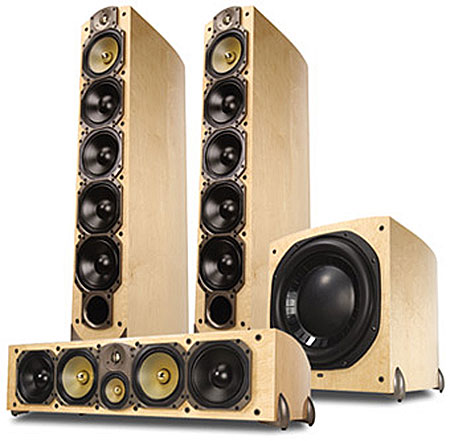Paradigm Reference Signature Speaker System

Paradigm takes a methodical, highly sophisticated approach to speaker design. Extensive measurements are performed in its own anechoic chamber using software developed by its own engineers, and double-blind listening tests are part of the routine. And, unlike speaker manufacturers whose sole concession to multichannel sound is to turn a front-channel speaker on its side to serve as a center-channel, Paradigm has designed center-channel speakers that take into account the distinct role of this speaker in a multichannel system. They've also developed dipole surround speakers, which produce a more diffuse soundfield.
Features
Paradigm's Reference Signature series includes five L/R models (S1, S2, S4, S6, S8). The top-of-the-line S8, provided to serve the front L/R channels in this review system, is a three-way floorstander with four 7-inch bass drivers, a 7-inch midrange, and a 1-inch tweeter. There's a port in the front and another in the rear.
 The front baffle is kept narrow (just over 8 inches) to reduce diffraction, and the cabinet widens from the front then tapers toward the back. The polished wood finish provides an elegant appearance, with a quality that is considerably above Paradigm's other speakers, including the next-to-the-top Reference Studio line.
The front baffle is kept narrow (just over 8 inches) to reduce diffraction, and the cabinet widens from the front then tapers toward the back. The polished wood finish provides an elegant appearance, with a quality that is considerably above Paradigm's other speakers, including the next-to-the-top Reference Studio line.
There are three dedicated center-channel speakers in the Reference Signature series (C1, C3, C5). The C5, intended to provide the most appropriate match with the S8, is described as a "6-driver, 3-1/2-way system." It features a pair of the same bass and midrange drivers as the S8 flanking a 4-inch midrange driver with the tweeter (same as the S8's) right above it. Two ports are located on the rear of the cabinet.
At first glance, the C5 looks like a shorter version of the S8 turned sideways, but the dimensions are entirely different—and also different than the S6—so this is not just a box that's already being used for another speaker. The C5 weighs in at 81 pounds, compared to the S8's 100 pounds and the S6's 70 pounds. This is one serious center-channel speaker.
The ADP3 side/rear speaker is much smaller, but it's still a 3-way configuration, with an 8-inch bass driver facing the listening area and two 4-inch midrange/1-inch tweeter pairs firing sideways in a dipole configuration (out of phase with each other). Unlike the ported S8 and C5, the ADP3 is a sealed-box design, and its rated sensitivity is 3dB lower than the 89dB of the S8 and the C5. (Of course, this difference can be taken care of in the surround-processor setup, and 86dB isn't that low.)
All front, center, and surround speakers in the Reference Signature line, as well as the Reference Signature subwoofer, are now in their second version, which includes numerous improvements. My review system was completed by the Reference Signature Servo subwoofer, the original version of which was reviewed by Fred Manteghian.
Most manufacturers of speaker systems don't have the expertise or the resources to make the actual drivers, so they buy them from specialist manufacturers. Paradigm is one of the few speaker companies to design and manufacture its own drivers. In fact, not only does it manufacture the drivers, but it has also made the machinery that makes the drivers. No outsourcing here, no sirree! The advantage of this approach is that it allows control over every aspect of the design process and the highest level of quality control.
The Reference Signature drivers were specially designed for this line, with high-tech features like cobalt-infused aluminum midrange and bass-midrange cones, mineral-filled polypropylene bass cones, die-cast aluminum chassis, computer-optimized super-neodymium magnet structures, lightweight aluminum- or copper-wire voice coils, etc. The star among the drivers is probably the tweeter, which has a dome made of pure beryllium, a material that—while expensive and difficult to work with—has been widely recognized as offering an optimal combination of rigidity and low weight.





























































